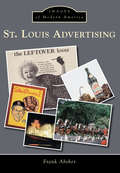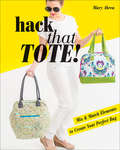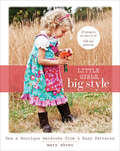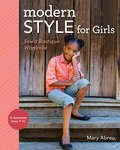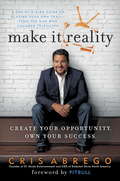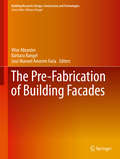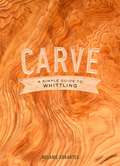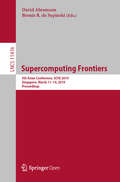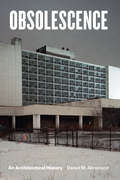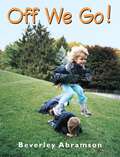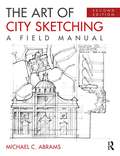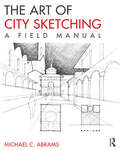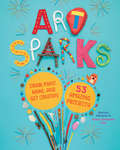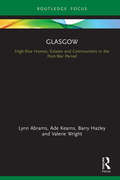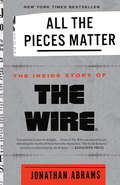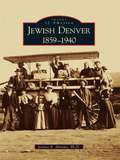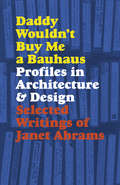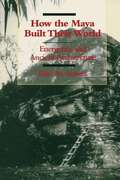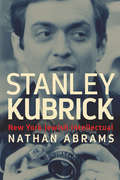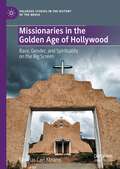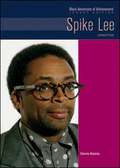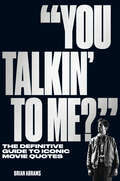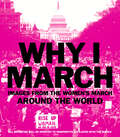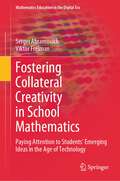- Table View
- List View
St. Louis Advertising
by Frank AbsherMention "advertising," and just about everyone thinks of New York's Madison Avenue, long the center of the nation's advertising universe. The reality is that advertising is everywhere and has been almost since the inception of the nation. In St. Louis, for example, two early advertising agencies became major players on the national scene, creating advertising for multinational corporations. Browsing through this collection of old advertisements gives readers a chance to follow the development of the nation's business community over the past 200 years and see what was important in the daily lives of Americans, as well as what the nation's commercial interests wanted them to believe was important.
John Ruskin: The Passionate Moralist
by Joan AbseJoan Abse treats Ruskin with deep and proper respect from start to finish; and she writes best of all on his ideas about art and artists.
Hack That Tote!: Mix & Match Elements to Create Your Perfect Bag
by Mary Abreu“A terrific book for the beginner bag maker and anyone looking for fairly quick and easy bag projects” —from a wine-bottle bag to a zip-top purse (Homespun).One pattern . . . infinite looks! With simple tweaks, you can reinvent the basic tote 11 ways, sewing useful projects like a backpack, messenger bag, laundry duffle, and stylish cross-body purse. Create your perfect carryall by adding pockets, leather handles, fabric straps and tabs, O-rings, snap hooks, purse frames, and more for endless variety. A fabric and interfacing guide helps beginners and more experienced sewists choose the right materials every time. Just measure, mark, and cut—no printed patterns needed!Alter a basic tote 11 ways! Switch up the size, shape, pockets, straps, drawstrings, zippers, and hardware to create bags for many usesExpert tips on choosing the right fabric and interfacing for sturdy bags that look amazingEasy, dimensional cutting instructions for fast, professional results“In this beginner-friendly guide, Abreu (Modern Style for Girls) takes a basic square tote pattern and adjusts it in a variety of ways to create a wardrobe of attractive bags in different shapes and styles, from casual and functional to structured and sophisticated.” —Library Journal“Join Abreu as she takes a basic tote bag pattern and transforms it 11 different ways by varying the shape and size of her bags, as well as the detailing such as pockets, handles, and, of course, color and fabric combinations. By following Mary’s tips, you'll create professional-looking bags for yourself and friends.” —Quilter’s Companion
Little Girls, Big Style: Sew a Boutique Wardrobe from 4 Easy Patterns
by Mary AbreuLearn to create unique, well-fitted clothing for your little ones with this illustrated guide featuring 4 easy patterns and 23 projects in sizes 2-6.In Little Girls, Big Style, author and professional seamstress Mary Abreu offers a comprehensive guide to making beautiful clothes that fit your daughter—and your budget—perfectly. Every day can be dress-up day when you mix and match the four basic patterns featured in this book to create hundreds of adorable outfits. Mary makes this guide beginner-friendly with complete instructions on all the basics-finishing seams, gathering, topstitching, hemming, shirring, and more. She also offers tips on how to make each item your own with your favorite fabrics and embellishments. Everything you need to learn is here, from the basic sewing to the stylish finishing.
Modern Style for Girls: Sew a Boutique Wardrobe
by Mary Abreu“Designed [for] the tastes of the tween . . . from a simple and stylish vintage-inspired A-line collared dress to a gorgeous paneled skirt.” —Love SewingBestselling author Mary Abreu is back with a book that will shut down the dreaded words, “I have nothing to wear!” from young girls. Starting with three basic pieces—a top/dress, skirt, and pants—you’ll learn how to modify simple patterns and rectangles to make twelve classic garments: four tops/dresses, four shorts/pants, and four skirts. Technique instructions teach you how to gather, create waistband casings, and insert zippers. Advice on choosing fabrics and adding embellishments is also included. With this handy guide, you can help your girls develop a style all their own.Add collars, change armholes, and add ruffles to basic garments to create updated takes on existing piecesClear techniques will guide you on how to finish seam allowances, insert zippers, hem, and add unique embellishmentsHelp your girls create an entirely new wardrobe of classic pieces to mix and match in any way they want “The focus here is on sizes seven to 12—an age in which girls want clothes that don’t look babyish but are still appropriate for play. Designs include tops, dresses, pants, shorts, and skirts, and the style is charmingly retro—think pedal pushers and Peter Pan collars but in contemporary fabrics . . . Most pattern books for children’s clothing concentrate on smaller-sized clothing for babies, toddlers, and preschoolers, so the focus on school-aged children’s clothing makes this a nice addition for sewing collections.” —Library Journal
Make It Reality: Create Your Opportunity, Own Your Success
by Cris Abrego PitbullThe creator and producer of several mega-hit television series, including The Surreal Life, Flavor of Love, Rock of Love, and Charm School, shares his incredible journey of making it to the top--and how you can too. "No one paves the road for you. You have to create your own path. If you believe in your dreams, embrace what makes you different, and bet on yourself, the destination will be greater than you ever imagined."--Cris Abrego From carrying camera gear on the sets of MTV's Road Rules, to pioneering the celebreality genre by creating such breakout hits as The Surreal Life and The Flavor of Love, and now as one of today's most prominent figures in the television industry--Cris Abrego's career has been nothing short of extraordinary. As a young boy growing up in L.A., Abrego spent his formative years glued to his family's TV set, forging his dream of one day working in television. With unrelenting drive, he overcame countless obstacles to build his own reality TV production company in his garage, which, by his mid-thirties, he sold to one of the world's largest television production companies, before being tapped as their co-CEO. In Make It Reality, Abrego provides practical and motivating lessons collected from almost twenty years on the frontlines of television, including: how to visualize and your goals and work tirelessly to attain them; when to take risks and push boundaries; and how to continually raise the bar for yourself and realize there are no limits on what can be achieved. Success isn't about your pedigree or your connections: it's about vision, leadership, and courage. Abrego's story is unforgettable, full of heart, and inspiring to anyone seeking to transcend all obstacles and achieve true success.Foreword by PitbullFrom the Hardcover edition.
The Pre-Fabrication of Building Facades
by Vítor Abrantes Bárbara Rangel José Manuel Amorim FariaThis book compares two buildings with different technologies and distinct environment from the combined viewpoints of civil engineering and architecture. The first is the most recent building of Columbia University in New York, the Northwest Science Building, a project designed by Rafael Moneo and Dan Brodkin of Ove Arup. The second one is the Burgo Tower in Oporto, by Eduardo Souto Moura and Rui Furtado of AFA, a building that brings a new perspective to the use of prefabrication technologies with local traditional construction systems. With the detailed analyses of recognized researchers in civil engineering and architecture, this book is a reflection upon the problems and solutions in the design and construction process of a prefabricated building system. This volume, like those to follow, brings together, building research and building design practice to enhance the knowledge of complementarity areas involved in construction, engineering and architecture. This is the first book in a new series "Building Research: Design, Construction and Technologies" which aims to bridge scientific research and professional practice to understand the Building Design problems. In each edition, one or two case studies (recognized buildings in the international design panorama) are analyzed with their authors to assess the design process and the construction development. To understand the problems involved, researchers, engineers and architects, are asked to contribute to this ana lysis with essays on building research issues, as building technology, construction management, acoustics, maintenance or prefabrication.
Carve: A Simple Guide to Whittling
by Melanie AbrantesWhittle a beautiful spoon, comb, pair of dice, and more with this fresh introduction to a folksy craft. Carve modernizes a mindful hobby that people have turned to for generations to help them slow down, relax, and connect with the outdoors. Choose from a dozen projects with bespoke details, all are designed to be useful at home or while camping. And because these objects are small, they require only a few hours and a tool or two to complete. You'll also learn how to choose the right knife and wood, helpful information on techniques and safety, and tips for refining, personalizing and maintaining your piece. Whether you're headed to the woods or just to the porch, this pocket-sized guide will have you carving your own unique designs in no time.From the Hardcover edition.
Supercomputing Frontiers: 5th Asian Conference, SCFA 2019, Singapore, March 11–14, 2019, Proceedings (Lecture Notes in Computer Science #11416)
by David Abramson Bronis R. de SupinskiThis open access book constitutes the refereed proceedings of the 5th Asian Supercomputing Conference, SCFA 2019, held in Singapore in March 2019. The 6 full papers presented in this book were carefully reviewed and selected from 33 submissions. They cover a range of topics including memory fault handling, linear algebra, image processing, heterogeneous computing, resource usage prediction, and data caching.
Obsolescence
by Daniel M. AbramsonIn our architectural pursuits, we often seem to be in search of something newer, grander, or more efficient--and this phenomenon is not novel. In the spring of 1910 hundreds of workers labored day and night to demolish the Gillender Building in New York, once the loftiest office tower in the world, in order to make way for a taller skyscraper. The New York Times puzzled over those who would sacrifice the thirteen-year-old structure, "as ruthlessly as though it were some ancient shack." In New York alone, the Gillender joined the original Grand Central Terminal, the Plaza Hotel, the Western Union Building, and the Tower Building on the list of just one generation's razed metropolitan monuments. In the innovative and wide-ranging Obsolescence, Daniel M. Abramson investigates this notion of architectural expendability and the logic by which buildings lose their value and utility. The idea that the new necessarily outperforms and makes superfluous the old, Abramson argues, helps people come to terms with modernity and capitalism's fast-paced change. Obsolescence, then, gives an unsettling experience purpose and meaning. Belief in obsolescence, as Abramson shows, also profoundly affects architectural design. In the 1960s, many architects worldwide accepted the inevitability of obsolescence, experimenting with flexible, modular designs, from open-plan schools, offices, labs, and museums to vast megastructural frames and indeterminate building complexes. Some architects went so far as to embrace obsolescence's liberating promise to cast aside convention and habit, envisioning expendable short-life buildings that embodied human choice and freedom. Others, we learn, were horrified by the implications of this ephemerality and waste, and their resistance eventually set the stage for our turn to sustainability--the conservation rather than disposal of resources. Abramson's fascinating tour of our idea of obsolescence culminates in an assessment of recent manifestations of sustainability, from adaptive reuse and historic preservation to postmodernism and green design, which all struggle to comprehend and manage the changes that challenge us on all sides.
Off We Go!
by Beverley AbramsonThe natural state of toddlers and young children is motion, and Beverley Abramson’s splendid photographs are an appreciation of the many ways in which we can move. Children spin and whirl, run, jump, and climb through the seasons in photographs that beg for discussion and storytelling.Whether it is flying a kite or kicking a ball, skipping on the grass or riding a tricycle, Beverley Abramson has captured kids experiencing the sheer pleasure of exploring the world through movement. Best of all, it is an invitation to get children to discover the fun of physical play.
The Art of City Sketching: A Field Manual
by Michael C. AbramsThe Art of City Sketching: A Field Manual guides readers through the process of freehand architectural sketching and explains orthographic, diagrammatic, three-dimensional, and perceptual-type drawings. The book presents hundreds of drawings of historic buildings and urban spaces, examples, and exercises, which help readers develop their drawing skills and employ sketching as an analytical tool. The book is divided into three parts, based on the reader’s skill level: beginner, intermediate, and advanced. As an architect and field sketching instructor, the author shows that through drawing the reader can discover, analyze, and comprehend the built environment. The new edition of The Art of City Sketching expands on the drawing techniques of the previous version by adding new drawing examples, exercises, and two new chapters—Chiaroscuro and Storyboard. New drawing tips, demonstrations, and composition "do’s and don’ts" will support readers when they illustrate their viewpoint of the city by using simple drawing tools. The lessons in this book will allow readers to mix method with imagination and sensibility.
The Art of City Sketching: A Field Manual
by Michael AbramsThe Art of City Sketching: A Field Manual guides you through the laborious and sometimes complex process of sketching what you see in the built environment so that you can learn to draw what you imagine. Illustrated with hundreds of drawings by students and professionals of cityscapes around Europe and the United States, the book helps you develop your conceptual drawing skills so that you can communicate graphically to represent the built environment. Short exercises, projects, drawing tips, step-by-step demonstrations, and composition do's and don'ts make it easy for you to get out into the city and experiment in your own work. Author Michael Abrams uses his experience as a field sketching instructor, to show you that by drawing, you can discover, analyze, and comprehend the built environment.
Art Sparks: Draw, Paint, Make, and Get Creative with 53 Amazing Projects!
by Marion Abrams Hilary Emerson LayEvery kid can be an artist with this book as their guide! Using basic art supplies — from paint, markers, paper, and glue to household finds like cardboard boxes and fabric scraps — children aged 6 and up learn that as long as they can imagine it, they can create it. Curated by two art educators with decades of experience, this rich collection of 53 arts and crafts activities offers up a ton of freeform fun, from Doodlemonsters and Painted Animal Rocks to Paper Bead Jewelry and Nature Weaving. Projects vary in difficulty so there’s something for a wide range of ages and abilities, and many can be completed in under an hour. Each project featured in the book has been kid-made (and kid-approved!), and colorful photos of the finished pieces will ignite a creative spark that inspires budding makers to express their imagination, humor, and individuality through art. This publication conforms to the EPUB Accessibility specification at WCAG 2.0 Level AA.
Glasgow: High-Rise Homes, Estates and Communities in the Post-War Period (Built Environment City Studies)
by Lynn Abrams Ade Kearns Barry Hazley Valerie WrightIn the wake of an unparalleled housing crisis at the end of the Second World War, Glasgow Corporation rehoused the tens of thousands of private tenants who were living in overcrowded and unsanitary conditions in unimproved Victorian slums. Adopting the designs, the materials and the technologies of modernity they built into the sky, developing high-rise estates on vacant sites within the city and on its periphery. This book uniquely focuses on the people's experience of this modern approach to housing, drawing on oral histories and archival materials to reflect on the long-term narrative and significance of high-rise homes in the cityscape. It positions them as places of identity formation, intimacy and well-being. With discussions on interior design and consumption, gender roles, children, the elderly, privacy, isolation, social networks and nuisance, Glasgow examines the connections between architectural design, planning decisions and housing experience to offer some timely and prescient observations on the success and failure of this very modern housing solution at a moment when high flats are simultaneously denigrated in the social housing sector while being built afresh in the private sector. Glasgow is aimed at an academic readership, including postgraduate students, scholars and researchers. It will be of interest to social, cultural and urban historians particularly interested in the United Kingdom.
All the Pieces Matter: The Inside Story of The Wire®
by Jonathan Abrams<P>The definitive oral history of the iconic and beloved TV show The Wire, as told by the actors, writers, directors, and others involved in its creation. <P>Since its final episode aired in 2008, HBO's acclaimed crime drama The Wire has only become more popular and influential. The issues it tackled, from the failures of the drug war and criminal justice system to systemic bias in law enforcement and other social institutions, have become more urgent and central to the national conversation. <P>The show's actors, such as Idris Elba, Dominic West, and Michael B. Jordan, have gone on to become major stars. Its creators and writers, including David Simon and Richard Price, have developed dedicated cult followings of their own. Universities use the show to teach everything from film theory to criminal justice to sociology. Politicians and activists reference it when discussing policy. When critics compile lists of the Greatest TV Shows of All Time, The Wire routinely takes the top spot. It is arguably one of the great works of art America has produced in the 20th century. <P>But while there has been a great deal of critical analysis of the show and its themes, until now there has never been a definitive, behind-the-scenes take on how it came to be made. With unparalleled access to all the key actors and writers involved in its creation, Jonathan Abrams tells the astonishing, compelling, and complete account of The Wire, from its inception and creation through its end and powerful legacy. <P><b>A New York Times Bestseller</b>
Jewish Denver: 1859-1940 (Images of America)
by Jeanne E. AbramsIn 1859, during the Pike's Peak gold rush, at least 12 Jews joined the great migration to Colorado in search of gold and a brighter future. The unpredictability of mining and a growing demand for supplies encouraged many of these Jewish settlers to establish small businesses in Denver and in towns and mining camps across the state. By the early 1870s, Jewish benevolent societies and a congregation were established. Denver's dry, mild climate attracted patients with tuberculosis, and two Jewish sanatoriums were opened in the city around the beginning of the 20th century. Many of the predominantly Eastern European Jews who came in search of better health made Denver their home, thus augmenting the early Jewish population significantly. Today Jewish life flourishes in Colorado, and Jewish citizens continue to play a vital role in its culture and development.
Daddy Wouldn't Buy Me a Bauhaus: Profiles in Architecture and Design
by Janet AbramsDaddy Wouldn't Buy Me a Bauhaus collects the unparalleled writings of legendary British wordsmith Janet Abrams for the first time. From pivotal figures in international modernism to the pioneers of digital medium, Abrams explored the ideas, theories, and emotions that fueled their work.The book's twenty-six profiles, written in Abrams's signature, personal, often hilarious style, include Reyner Banham, Berthold Lubetkin, Philip Johnson, Paul Rand, Phyllis Lambert, Frank Gehry, Rem Koolhaas, Muriel Cooper, April Greiman, and Michael Bloomberg. Many of the profiles are back in print for the first time, having originally appeared in Blueprint, I.D. magazine, the Independent, and in books and catalogs from the 1980s through the early 2000s. A foreword by Blueprint's founding editor, Deyan Sudjic, and new reflections by Abrams set the stage.
How the Maya Built Their World
by Elliot M. AbramsMaya architecture is often described as "massive" and "monumental," but experiments at Copan, Honduras, convinced Elliot Abrams that 300 people could have built one of the large palaces there in only 100 days. In this groundbreaking work, Abrams explicates his theory of architectural energetics, which involves translating structures into volumes of raw and manufactured materials that are then multiplied by the time required for their production and assembly to determine the labor costs of past construction efforts. Applying this method to residential structures of the Late Classic period (A. D. 700-900) at Copan leads Abrams to posit a six-tiered hierarchic social structure of political decision making, ranging from a stratified elite to low-ranking commoners. By comparing the labor costs of construction and other economic activities, he also prompts a reconsideration of the effects of royal construction demands on commoners.
Stanley Kubrick: New York Jewish Intellectual
by Dr Nathan AbramsStanley Kubrick is generally acknowledged as one of the world’s great directors. Yet few critics or scholars have considered how he emerged from a unique and vibrant cultural milieu: the New York Jewish intelligentsia. Stanley Kubrick reexamines the director’s work in context of his ethnic and cultural origins. Focusing on several of Kubrick’s key themes—including masculinity, ethical responsibility, and the nature of evil—it demonstrates how his films were in conversation with contemporary New York Jewish intellectuals who grappled with the same concerns. At the same time, it explores Kubrick’s fraught relationship with his Jewish identity and his reluctance to be pegged as an ethnic director, manifest in his removal of Jewish references and characters from stories he adapted. As he digs deep into rare Kubrick archives to reveal insights about the director’s life and times, film scholar Nathan Abrams also provides a nuanced account of Kubrick’s cinematic artistry. Each chapter offers a detailed analysis of one of Kubrick’s major films, including Lolita, Dr. Strangelove, 2001, A Clockwork Orange, Barry Lyndon, The Shining, Full Metal Jacket, and Eyes Wide Shut. Stanley Kubrick thus presents an illuminating look at one of the twentieth century’s most renowned and yet misunderstood directors.
Missionaries in the Golden Age of Hollywood: Race, Gender, and Spirituality on the Big Screen (Palgrave Studies in the History of the Media)
by Douglas Carl AbramsThis book examines major British and American missionary films during the Golden Age of Hollywood to explore the significance of race, gender, and spirituality in relation to the lives of the missionaries portrayed in film during the middle third of the twentieth century. Film both influences and reflects culture, and racial, gender, and religious identities are some of the most debated issues globally today. In the movies explored in this book, missionary interactions with various people groups reflect the historical changes which took place during this time.
Spike Lee (Black Americans of Achievement--Legacy Edition)
by Dennis AbramsIn his own words, Spike Lee is the man who single-handedly "broke the color barrier" in Hollywood in the mid 1980s. In a film career that spans more than 20 years, Lee has established himself as one of the United States' premier filmmakers, a director whose films explore the many aspects of the African-American experience. Never one to shy away from controversy--he has been accused of racism, anti-Semitism, and sexism--Lee uses film to raise tough questions and to provoke discussion. How was he able to break down the doors of Hollywood for himself and for other African-American directors, actors, and technicians? How has he continued to grow and develop as a filmmaker? Spike Lee presents a nuanced portrait of an artist who has become a symbol of contemporary American culture.
"You Talkin' to Me?": The Definitive Guide to Iconic Movie Quotes
by Brian AbramsThis deep dive into hundreds of Hollywood&’s most iconic and beloved lines is a must-have for every film buff."You Talkin&’ to Me?" is a fun, fascinating, and exhaustively reported look at all the iconic Hollywood movie quotes we know and love, from Casablanca to Dirty Harry and The Godfather to Mean Girls. Drawing on interviews, archival sleuthing, and behind-the-scenes details, the book examines the origins and deeper meanings of hundreds of film lines: how they&’ve impacted, shaped, and reverberated through the culture, defined eras in Hollywood, and become cemented in the modern lexicon. Packed with film stills, sidebars, lists, and other fun detours throughout movie history, the book covers all genres and a diverse range of directors, writers, and audiences.
Why I March: Images from The Women's March Around the World
by Abrams BooksAn inspiring photographic account of the worldwide Women’s March of 2017—one of the biggest peaceful protests in history.On January 21, 2017, five million people in eighty-two countries and on all seven continents stood up with one voice. The Women’s March began with one cause, women’s rights, but quickly became a movement around the many issues that were hotly debated during the 2016 U.S. presidential race—immigration, health care, environmental protections, LGBTQ rights, racial justice, freedom of religion, and workers’ rights, among others. In the mere sixty-six days between the election and inauguration of Donald J. Trump as the 45th President of the United States, 673 sister marches sprang up across the country and the world. Why I March documents and honors the movement, gives back to it—and inspires future activism in the same vein.All royalties from the sale of this book will be donated to nonprofit organizations affiliated with the March.
Fostering Collateral Creativity in School Mathematics: Paying Attention to Students’ Emerging Ideas in the Age of Technology (Mathematics Education in the Digital Era #23)
by Sergei Abramovich Viktor FreimanThis book explores the topic of using technology, both physical and digital, to motivate creative mathematical thinking among students who are not considered ‘mathematically advanced.’ The book reflects the authors’ experience of teaching mathematics to Canadian and American teacher candidates and supervising several field-based activities by the candidates. It consists of eight chapters and an Appendix which includes details of constructing computational learning environments.Specifically, the book demonstrates how the appropriate use of technology in the teaching of mathematics can create conditions for the emergence of what may be called ‘collateral creativity,’ a notion similar to Dewey’s notion of collateral learning. Just as collateral learning does not result from the immediate goal of the traditional curriculum, collateral creativity does not result from the immediate goal of traditional problem solving. Rather, mathematical creativity emerges as a collateral outcome of thinking afforded by the use of technology. Furthermore, collateral creativity is an educative outcome of one’s learning experience with pedagogy that motivates students to ask questions about computer-generated or tactile-derived information and assists them in finding answers to their own or the teacher’s questions. This book intends to provide guidance to teachers for fostering collateral creativity in their classrooms.
